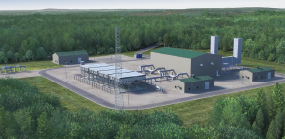Distributed power generation is any small scale power generation technology that provides electric power at a site closer to customers than central station generation, and is usually interconnected to the transmission or distribution system. Capacities may range from about 500 kilowatts to 25 megawatts. Various technologies, including some fueled by natural gas, are available for distributed generation, such as internal combustion enginelgenerators, small combustion turbine generators, photovoltaic solar panels, wind turbines, and fuel cells. Distributed generation may serve multiple roles, including standby generation, peak shaving capability, baseload generation, or in cogeneration applications.
Distributed power generation, often on site, was the norm during the first part of the twentieth century. Now technical, regulatory, and economic influences along with increased environmental concerns are again making dispersed, rather than central, sources of electricity competitive economic options for many utility and end user applications. Distributed sources of power have the potential for comprising about 20 percent of additions to generating capacity in the United States over the next two decades. Gas-fired distributed generation technologies expected for commercial application by the end of the century are internal combustion enginelgenerators, small combustion turbine generators, and fuel cells.
The natural gas industry has a great opportunity to profit from these changes in the electric utility industry, although it must take some actions to benefit. These include involving itself in the electric utility industry’s discussions on distributed generation to raise the visibility of natural gas, continuing research to improve efficiencies and reduce pollutant emissions of gas-frred technologies, and watching for business opportunities in locations where clean burning natural gas is economically available and where incremental power is required.



